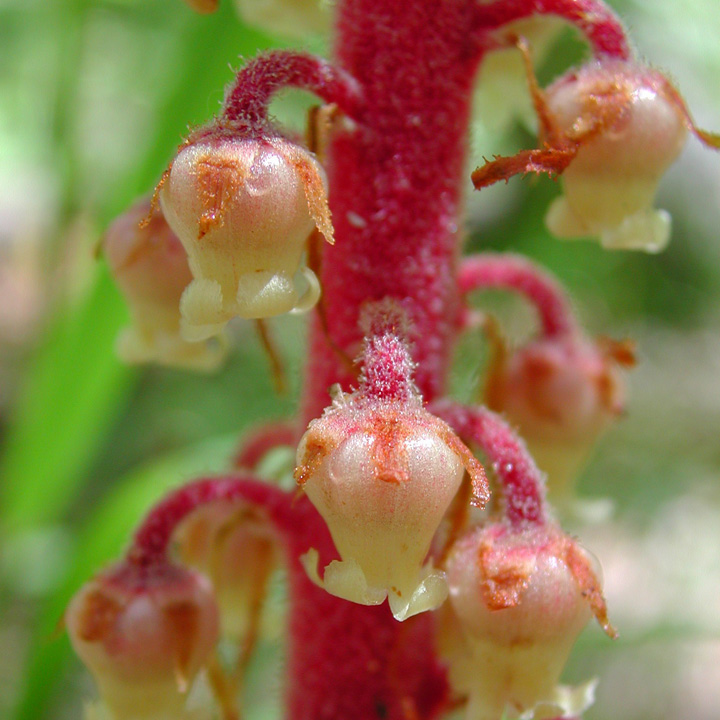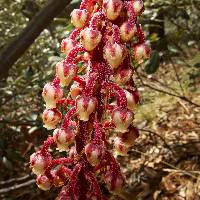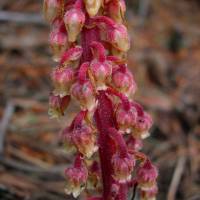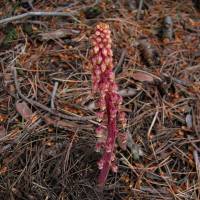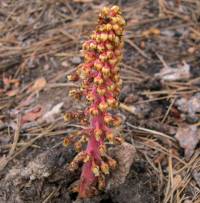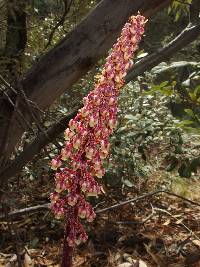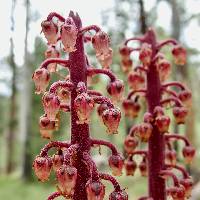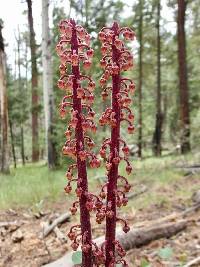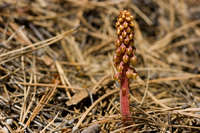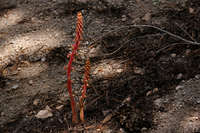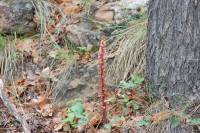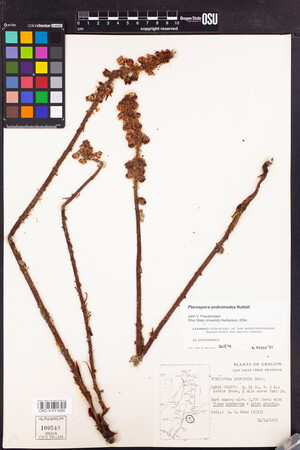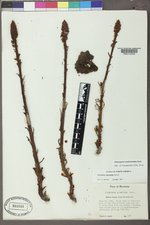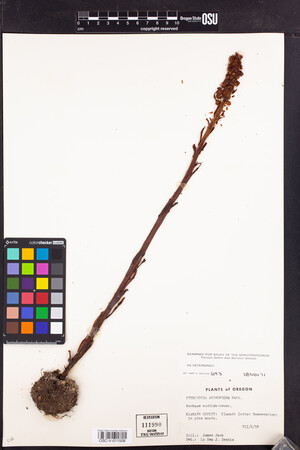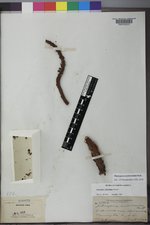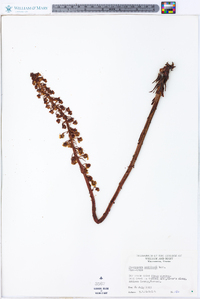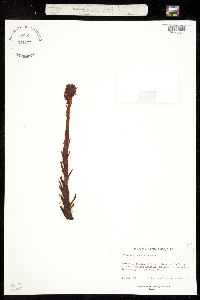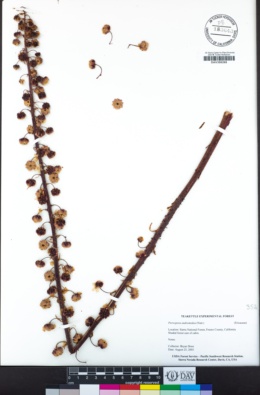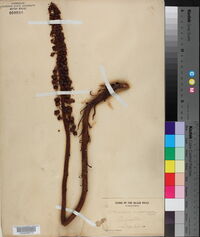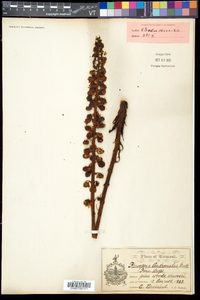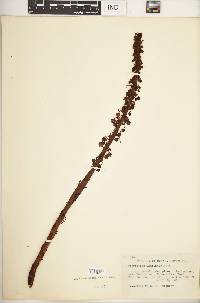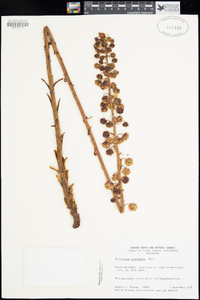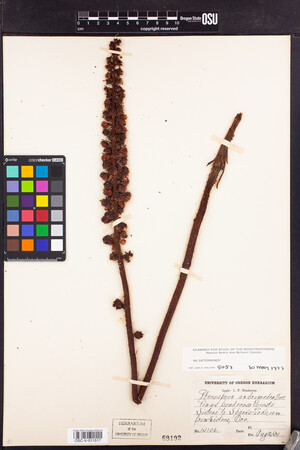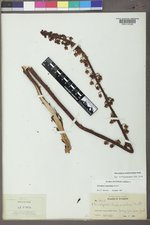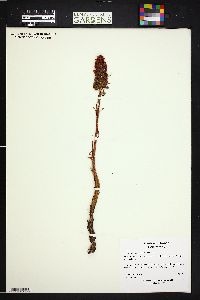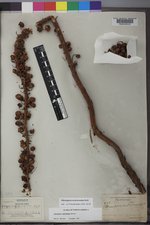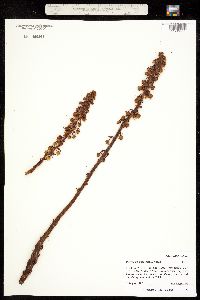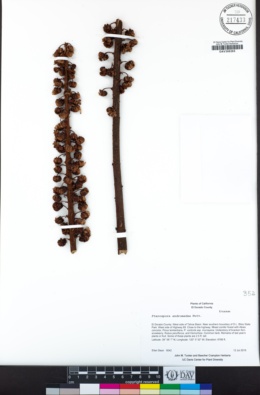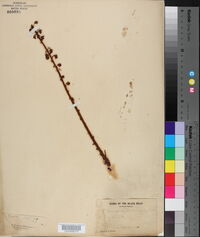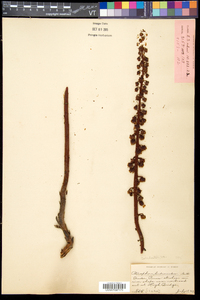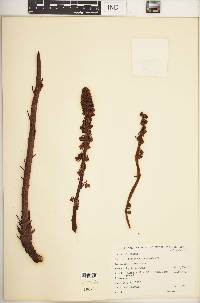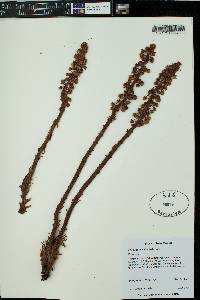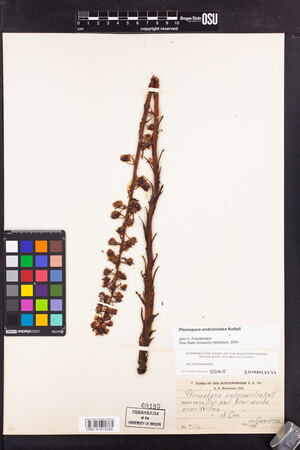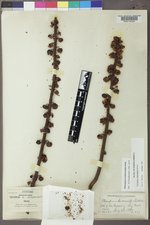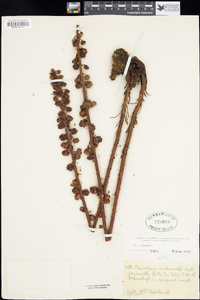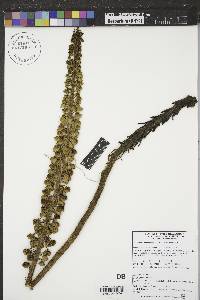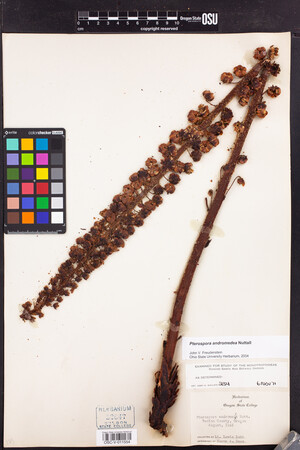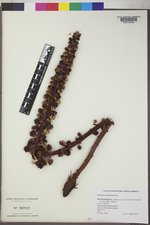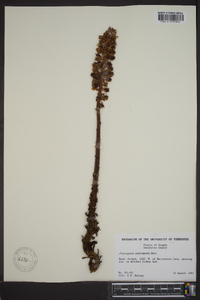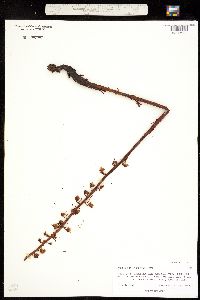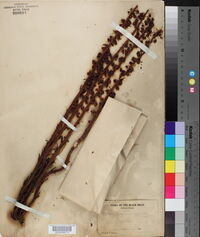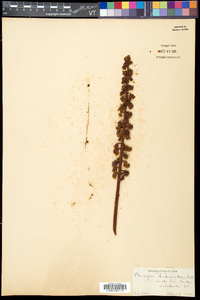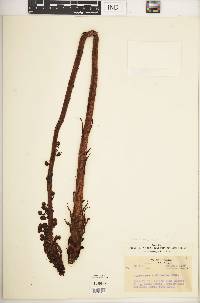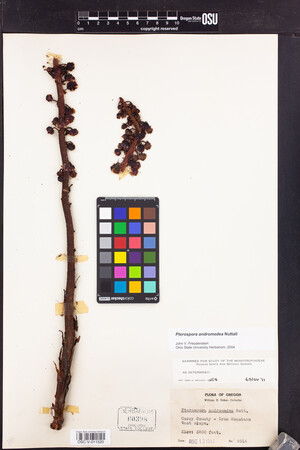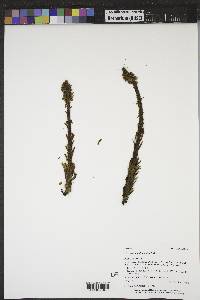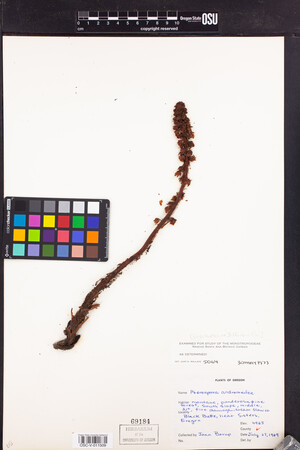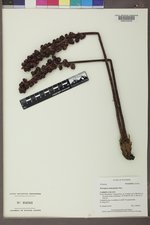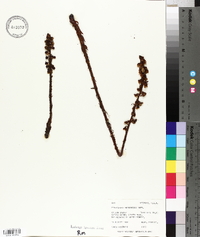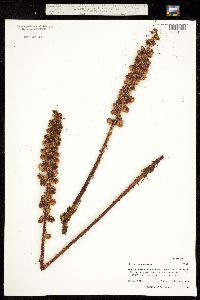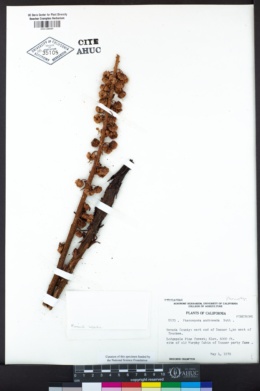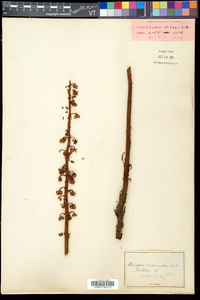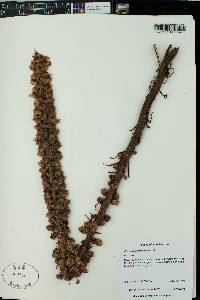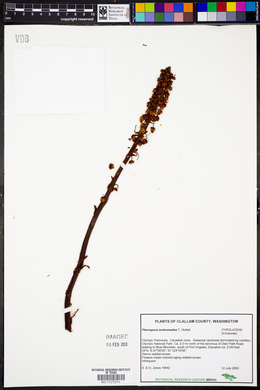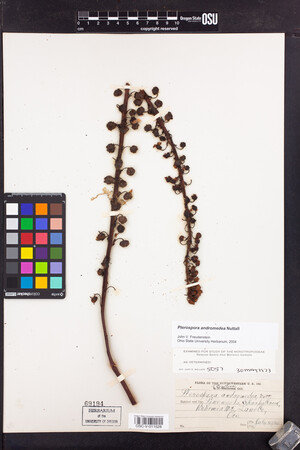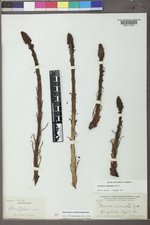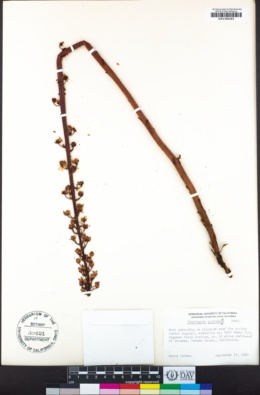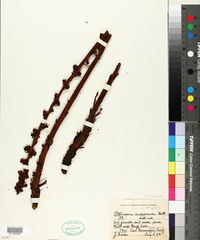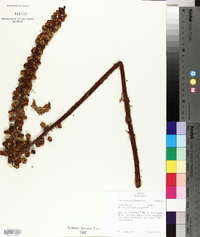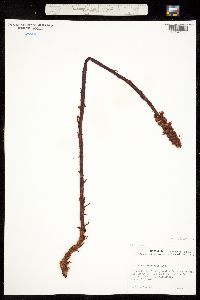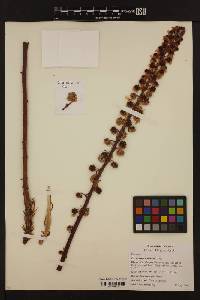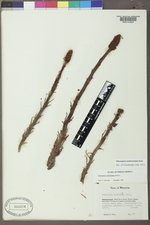Pterospora andromedea
|
|
|
|
Family: Ericaceae
Woodland Pinedrops
|
Inflorescences 1.5-17 dm , glandular-hirsute; bracts 2-3.5 × 0.5-1 cm, scarious at maturity. Flowers: sepals 4-6 × 2-3 mm; corolla 6-9 mm, base not saccate, lobes reflexed, rounded to blunt; stamens 3-5 mm; anthers horizontal at anthesis, ca. 1 mm diam., awns to 1.5 mm; ovary 3-4 × 4-6 mm, glabrous; style 1-3 × 1 mm; stigma yellowish, ca. 1.5 mm diam. Capsules persistent, thin-segmented, remaining connate at apex, 5-10 × 7-14 mm. Seeds 0.2-0.5 mm including wing. 2n = 16, 48. Flowering summer. Moist to dry, often deep humus of mixed-deciduous or coniferous forests (sometimes on calcareous substrates); 60-3700 m; Alta., B.C., N.B., Ont., P.E.I., Que., Sask.; Alaska, Ariz., Calif., Colo., Idaho, Mich., Mont., Nebr., Nev., N.H., N.Mex., N.Y., Oreg., S.Dak., Tex., Utah, Vt., Wash., Wyo.; Mexico (Chihuahua, Durango, Nuevo León). Plant: Perennial, mycotrophic herb; Flowering stems erect, fleshy, reddish-brown, densely glandular-hairy, 1-several from a dense spherical root mass, to 1 m tall, the inflorescence terminal Leaves: no green leaves INFLORESCENCE: terminal; bracts triangular, overlapping, clustered near base of stem, becoming reduced linear-lanceolate and scattered above, merging with the inflorescence bracts Flowers: nodding, whitish, yellow or pink, numerous in an elongate, open raceme-like inflorescence, at times clustered in groups of 2-5; sepals 5, separate, linear-lanceolate, glandular, to 5 mm long; corolla fused, urn-shaped, persistent, the lobes 5, reflexed; stamens 10, the filaments smooth; anthers ovoid with two recurved awns the length of the sacs; pollen grains four-grooved, many aborted; style short, columnar; stigma capitate, obscurely 5-lobed Fruit: FRUITS 5-locular, nodding, depressed-globose capsules, 8-12 mm wide; SEEDS ovoid, tapered to one end, with 5 ribs and a conspicuous rounded wing larger than the seed body Misc: Coniferous, especially pine, forests; 1800-2900 m (6000-9500 ft); Jun-Aug REFERENCES: Haber, Erich. 1992. Monotropaceae. Ariz.-Nev. Acad. Sci. 26(1)2. FNA 2009, Haber 1992 Duration: Perennial Nativity: Native Lifeform: Forb/Herb General: Parasitic, herb which is symbiotic with fungus, having a simple stalk, reddish-brown in color, whole plant densely glandular-hairy, can produce several stems from a ball-like root mass, up to 1 m tall. Leaves: This plant lacks chlorophyll and has no true leaves, however, sometimes scales growing on the stalk can protrude outward and have the appearance of leaves. Flowers: Small, bell-shaped, white, cream, or pink flowers, nodding, the inflorescence forming a dense, overlapping cluster at the terminal portion of the stalk. Each flower is supported on a slender pedicel, with 5 triangular sepals, also reddish. The flowers have 5 reflexed lobes at the tips, forming a narrow opening. Stamens 10, anthers having 2 recurved awns the length of the sacs. Fruits: Small, rounded capsules, nodding, 5 locular, seeds are small, round, and red when young, having a translucent, rounded wing protruding from one side. Ecology: Found on calcareous substrates in mixed deciduous and coniferous (pine) forests, from 6,000-9,500 ft (1829-2896 m); flowers June-August. Notes: This interesting, parasitic plant enjoys the cooler temps found in coniferous forests, especially pine forests. Look for its red stalks sprouting in unlikely places, especially in damp areas or areas with well-composted duff. The tiny seeds are especially cool with their transparent wings, reminiscent of fly wings. The stalks can sometimes be sticky to the touch. Ethnobotany: An infusion of the plant was taken to treat lung hemorrhages, and used as an emetic, externally, an infusion was used as an astringent, and snorted to treat nosebleeds, an infusion of the roots were taken to treat gonorrhea. The plant was was roasted and eaten, and the leaves were smoked in the kiva. Etymology: Pterospora is from the Greek pteron for wing and sporos for seed, while andromedea means resembling Andromeda (the genus of bog-rosemary). Synonyms: None Editor: LCrumbacher, 2011 Stems erect, simple, 3-10 dm, glandular-hairy, with numerous scale-lvs especially below; fls numerous in a terminal raceme 1-3 dm; cor 6-7 mm, white to more often reddish, its spreading-recurved lobes 1-2 mm; 2n=16. Coniferous woods, chiefly in dry soil; P.E.I. to N.Y. and Pa., w. to s. Ont. and Mich.; widespread in the w. cordillera, from s. Can. to Mex. June-Aug. Gleason, Henry A. & Cronquist, Arthur J. 1991. Manual of vascular plants of northeastern United States and adjacent Canada. lxxv + 910 pp. ©The New York Botanical Garden. All rights reserved. Used by permission. |
|
|
|

